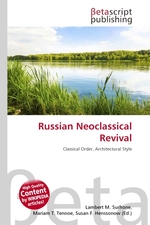Russian Neoclassical Revival
Lambert M. Surhone, Mariam T. Tennoe, Susan F. Henssonow
бумажная книга
High Quality Content by WIKIPEDIA articles! Russian neoclassical revival was a trend in Russian culture, mostly pronounced in architecture, that briefly replaced eclecticism and Art Nouveau as the leading architectural style between the Revolution of 1905 and the outbreak of World War I, coexisting with the Silver Age of Russian Poetry. It is characterized by merger of new technologies (steel frame and reinforced concrete) with moderate application of classical order and the legacy of Russian empire style of the first quarter of 19th century. Revival school was most active in Saint Petersburg, less in Moscow and other cities. The style was a common choice for luxury country estates, upper-class apartment and office buildings; at the same time it was practically non-existent in church and government architecture. Neoclassical architects born in 1870s, who reached their peak activity in 1905-1914 (Ivan Fomin, Vladimir Shchuko, Ivan Zholtovsky), later became leading figures in stalinist architecture of 1930s and shaped Soviet architectural education system.
Данное издание не является оригинальным. Книга печатается по технологии принт-он-деманд после получения заказа.


